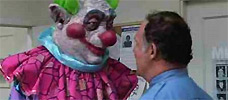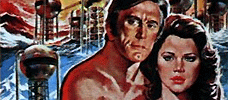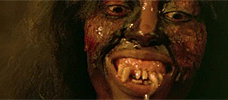Reviews
Kurutta ippêji
Teinosuke Kinugasa
Japan, 1926
Credits
Review by Sam Bett
Posted on 14 October 2009
Source Notavailableondvd.com DVD
Categories 31 Days of Horror VI
The fast shuffle of images in the opening frames of A Page of Madness is enough to leave one disoriented and agitated. There are saturated nighttime shots of narrow streets, locomotive wheels, and rainwater rushing over the streets. A haunting yet simple soundtrack of tympanis, howling flutes, and clockwork-like chatter. Then, a slow zoom onto a giant, furry, striped ball revolving on an axle, with a woman in flowing robes dancing before it. Next, a female dancer whirling with frenetic energy, and white lightning bolts layered over shots of barred windows that reveal only the rainy night. These images all mix together and flood over us, inundating our senses and leaving us to wonder where we’ve arrived. But rather than pushing us away, these first disorienting images help acclimate us to the psychological atmosphere of the film, making us more receptive and perhaps even more sympathetic to the coming scenes.
A Page of Madness is the story of a Japanese mental hospital. The narrative is patchy and scattered even by today’s standards, but never so disjointed to be incomprehensible. Images of one character slip and cut to images of others, revealing first the associations between characters while only sporadically introducing personal information. A shot of the tortured dancer pans past her cell door to the right, leading us to the deranged middle-aged woman in the cell next to hers. This woman’s thrashes and flashbacks introduce us to her husband, an older man who has taken up the job of janitor at the hospital in an attempt to gain control over his slipping relationship with his wife—the struggle that becomes the focus of A Page of Madness.
The janitor’s wife is haunted by nightmarish fantasies of lost control and separation. The most potent of these is represented by an image of a woman with a baby superimposed over an image of an object being thrown into a river. The thrown object splashes into the water at the exact same position as the child’s face, linking the image of the baby with a sensation of mental explosion. This layered graphic matching also associates the child with notions of abandonment: the Japanese word mizuko, which literally means “water-child,” refers to both stillborn births and induced abortions, and thus this image suggests both a loss and a refusal of life for both mother and child. Through images and symbols such as these, we gradually enter the lives of the inhabitants of this mental hospital; and because the images are so freely structured and spasmodic, their representation leaves us with both information and a lingering sensation of interaction with the disturbed mental state of these characters.
Much like us viewers, the janitor too soon finds himself sensually involved in the unstable emotional climate of the hospital. Daydreaming (or perhaps hallucinating) as he looks out the window of his room, he sees a parade marching down the road outside and soon finds himself absorbed into its activity. The regular motion and cheery brass music of the procession betrays the janitor’s desire for order and control, and contrasts starkly with the bedlam and the neurotic, primal drumbeats of the hospital, into which the janitor soon finds himself reabsorbed.
In a later fantasy, he reaches again for control and regulation when he finds a crate of Kyogen (literally “words of madness”) and Noh masks and distributes them to the hospital’s patients. The drumbeats become vigorous and lively, and the patients in their smiling masks become suddenly cheerful and placid. The janitor himself dons a mask and stands with his wife and children, the couple tilting their heads in complacence. The fantasy ends with a shot of the janitor pushing a mop across an empty room, as if wiping the false comforts of the delusion away in order to deal with the very real emptiness that surrounds him.
What this and all the other fantasies of the film collectively reveal is pervasive effort to communicate. The janitor tries endlessly to reach his wife and pull her out of her madness. The wife, stricken by phantoms, is unable to articulate her horrors but expresses her terror and suffering with screams and moans. The dancer, who unlike most other patients is locked in a cell, is constantly in motion despite her inability to speak. Her uncanny skill as a dancer is evident in her every appearance, but one scene frames the communicative ability of her dancing perfectly.
As if provoked by a fire, dozens of patients suddenly crowd to the bars of the dancer’s cell. Their faces twitch and they grab the bars of the door, and the camera cuts back and forth between them and the feverish dancer. This scene predates a strikingly similar one in Fritz Lang’s Metropolis, where the false Maria makes her genteel audience twitch and sweat with lusty rapture. In both cases, a mute woman arrests the attention of her audience through dance. For these women, dance is a display of both power and limitation. While the false Maria is a tool of the Metropolis, this dancer is confined to her cell. The potency of both dances does not change the fact that neither woman can be free.
As we witness scene after scene of madness, we become accustomed to the language of this world. A Page of Madness gradually narrows the gap between “sane” and “insane” by provoking our senses and suggesting that insanity is not a disease, but a sensation that can be communicated and even transferred to others. Kinugasa takes the visual format of his characters’ fantasies and the physical, sensual agitation of their condition and crafts them into a story told in their own language. The result is an engulfing creation that activates our sympathy and pushes us to question our definition of madness.
More 31 Days of Horror VI
-

From Beyond
1986 -

The Haunting
1963 -

Killer Klowns from Outer Space
1988 -

Shock ‘Em Dead
1991 -

Critters
1986 -

Critters 2
1988 -

The Fall of the House of Usher
1928 -

Jonestown: The Life and Death of Peoples Temple
2006 -

In the Mouth of Madness
1994 -

Winterbeast
1991 -

Black Roses
1988 -

Needful Things
1993 -

The Seventh Victim
1943 -

A Page of Madness
1926 -

Holocaust 2000
1977 -

The Man and the Monster
1958 -

The Texas Chainsaw Massacre 2
1986 -

Trick or Treat
1986 -

Single White Female
1992 -

Trouble Every Day
2001 -

The Hands of Orlac
1924 -

The Devil’s Advocate
1997 -

Nocturne
1998 -

Hardware
1990 -

Hard Rock Zombies
1985 -

The Slumber Party Massacre
1982 -

Saw VI
2009 -

Zombi 4: After Death
1988 -

The Uninvited
1944 -

Hausu
1977
We don’t do comments anymore, but you may contact us here or find us on Twitter or Facebook.



